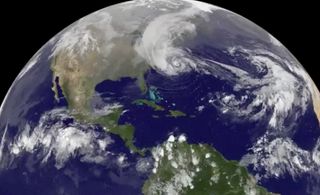2013 Atlantic Hurricane Names

Hurricane season in the Atlantic Ocean basin (which includes the northern Atlantic, the Gulf of Mexico and the Caribbean Sea) officially begins on June 1 and ends on Nov. 30 each year. There is a set list of names, determined by the World Meteorological Organization, that will be used for any storm that reaches tropical storm status or higher (tropical storms have winds of 39 mph, or 63 km/h, or higher).
Each list is used on a six-year rotating basis — so the names used for 2013 will be used again in 2019. New names are added to the list when an old name is retired, which happened most recently with Hurricane Sandy (it was replaced by "Sara" on the now-2018 list). Names are retired when the damage wrought by a storm would make using its name again insensitive to those affected by an earlier storm.
Each list of hurricane names in the Atlantic basin alternates between male and female names, running through the alphabet (though there are no names beginning with Q, U, X, Y or Z).
Below is the list of 2013 names. The list will be updated with the latest news on each storm as it forms.
Tropical Storm Andrea - Tropical Storm Andrea kicked off the 2013 hurricane season, forming in the Gulf of Mexico on the evening of June 5, then making landfall over Florida, dumping considerable amounts of rain and even spawning some tornadoes. The storm continued up the East Coast of the United States, continuing to drop heavy rain and causing flooding.
Sign up for the Live Science daily newsletter now
Get the world’s most fascinating discoveries delivered straight to your inbox.

Andrea Thompson is an associate editor at Scientific American, where she covers sustainability, energy and the environment. Prior to that, she was a senior writer covering climate science at Climate Central and a reporter and editor at Live Science, where she primarily covered Earth science and the environment. She holds a graduate degree in science health and environmental reporting from New York University, as well as a bachelor of science and and masters of science in atmospheric chemistry from the Georgia Institute of Technology.












